- First artwork recovered by the Estate with the assistance of Sotheby's: Aimée, A Young Egyptian (1869) by Emile Lecomte-Vernet (1821-1900). Press conference at Concordia: "Concordia announces the return of an important French painting lost to Max Stern during the Nazi regime."
- Painting is placed on loan to the Montreal Museum of Fine Arts.
- Press Release: "German Auction House to Proceed with Sale of Nazi-tainted art despite objections." After intense media scrutiny Van Ham Auction House in Cologne pulls two paintings: Market Scene in the Piazza Navona, Rome (1691) and Market Scene in the Piazza del Quirinale, Rome (1698) by Mathijs Naiveu (1647-1721). Paintings remain at Van Ham.
CHRONOLOGIES
Max Stern Estate chronology - key dates
1987
- Max Stern dies, leaving the bulk of his estate to Concordia University, McGill University and Hebrew University of Jerusalem and his private art collection to select museums across Canada, the United States and Israel.
1997
- 3,000 books from Stern's library are ceded jointly to the university beneficiaries.
2000
- Decision taken to sell the Dominion Gallery business in Montreal and its entire inventory.
- Concordia given the mandate to manage the operations of the Dominion Gallery and disperse its inventory of 5,000 works.
- Stern archives donated to the National Gallery of Canada.
2001
- Creation of The Max & Iris Stern Museums Legacy Program to commemorate the couple at museums in North America and Israel. Concordia is placed in charge of its administration.
2002
- As a result of the exposure of Dominion Gallery works in London and New York, Estate is notified that works belonging to Galerie Stern, Düsseldorf, dating from the Nazi period, are also circulating on the art market.
- Max Stern Art Restitution Project created and Concordia mandated to administer it.
- New York State Banking Commission’s Holocaust Claims Processing Office acknowledges Stern Estate's right to claim works.
- Missing works are added to the Art Loss Register in London and other registries in Germany and the United States.
- Philip Dombowsky, Cataloguer of the Max Stern Fonds at the National Gallery of Canada is mandated to prepare a first report on missing works.
- Willi Korte, lawyer, historian and looted art specialist is mandated to research the case. He is then engaged by the Estate as chief investigator on the Project.
2003
- Creation of The Max and Iris Stern Gallery on the Mount Scopus Campus of Hebrew University of Jerusalem.
- Creation of the Max Stern Curator position at the Leonard and Bina Ellen Gallery, Concordia University.
- Exhibition and Website: Highlights from the Max Stern Book Collection Bequest, McGill University and Concordia University.
2004
- Joint exhibitions celebrating Stern’s contributions are organized at the Montreal Museum of Fine Arts and the Leonard and Bina Ellen Gallery, Concordia University. The MMFA exhibition travels across Canada. Inauguration of the Max and Iris Stern Sculpture Garden at the Montreal Museum of Fine Arts.
- Creation of the Iris Westerberg Stern Programming Fund at the Leonard and Bina Ellen Gallery, Concordia University.
- Charles Hill, Curator of Canadian Art at the National Gallery of Canada, commissioned to prepare a biography on Max Stern.
2005
- New York State Banking Commission's Holocaust Claims Processing Office officially opens a claim for the Project.
- Girl from the Sabiner Mountains by F.X. Winterhalter (1805-1873) from Auktion 392 held at Lempertz in Cologne in 1937 is pulled from a local auction sale in Rhode Island.
- Provenance Research Program honours Max Stern at the Norton Museum of Art, West Palm Beach, Florida.
- Press conference at the Quebec Delegation in London: “Concordia Commits to Seeking Restitution of Max Stern’s Art Holdings Lost During the Nazi Regime”
- Catherine MacKenzie of the Department of Art History, Concordia University proposes an exhibition and publication on the 1937 sale of Stern's paintings at Lempertz.
2006
- Despite good-faith discussions, Estate discovers that the Winterhalter painting is illicitly transported from the USA to Germany by Baroness Von Morsey Pickard.
- Executors file suit against Baroness Von Pickard in Rhode Island.
- First Annual Max and Iris Stern International Symposium at the Musée d'art contemporain de Montréal together with press conference: "Concordia Announces Key Finding’s in the Search for Max Stern’s Art Holdings Lost During the Nazi Regime”.
- Opening of "Auktion 392: Reclaiming the Galerie Stern, Düsseldorf" (with accompanying catalogue and website) at Faculty of Fine Arts Gallery, Concordia University.
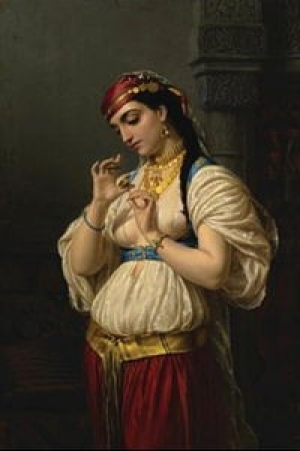 Emile C.H. Vernet-Lecomte (1821-1900)
Emile C.H. Vernet-Lecomte (1821-1900)
2007
- Auktion 392 exhibit opens at Leo Baeck Institute in New York.
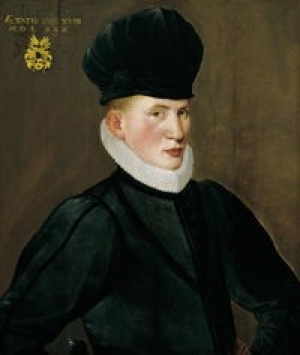 Nicolas Neufchatel (c. 1527-1590)
Nicolas Neufchatel (c. 1527-1590)
- Portrait of Jan Van Eversdyck by Nicolas Neufchatel (c.1527-1590) returned by the Jakober Foundation in Spain. Press Release: “Nazi-Looted Old Master Painting Returned to Stern Estate: One of many Stern Works Recycled in Recent Years Through German Auction Houses”.
- Neufchatel is placed on permanent loan to the Jakober Foundation.
- Van Ham Auction House issues its own press release “Painting from Max Stern Auction Rediscovered” stating that it has also pulled Winter Landscape by Gustav Lange (1811-1887) from an upcoming sale. Despite their press release, painting is returned to their consignor.
- Estate begins building a comprehensive database of Stern works from 1935-1937.
- Baroness Von Pickard’s Motion to dismiss the Winterhalter case is denied; The Court grants Estate a Preliminary Injunction enabling it to inspect the painting; Estate files a motion for Summary Judgment.
- Auktion 392 exhibit opens at Ben Uri Gallery (The London Jewish Museum of Art).
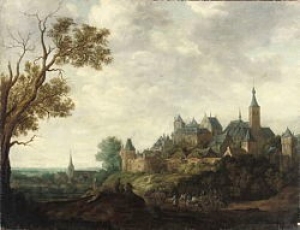 Jan de Vos I (1593-1649)
Jan de Vos I (1593-1649)
- "Extensive landscape with travelers on a track near a walled town with a castle and a church, a village beyond" by Jan de Vos I (1593-1649) returned with the assistance of Christie's in London.
- U.S. Federal Court judge Lisi rules in favour of Estate in Winterhalter case.
2008
- The Israel Museum Conference "Justice Matters: Restituting Holocaust-Era Art Artifacts" brings together speakers from Israel, Europe and North America. Sponsored by the Stern Estate, the Israel Museum Conference.
- In coordination with the conference, Auktion 392 exhibit opens at Max and Iris Stern Gallery of Hebrew University, Jerusalem.
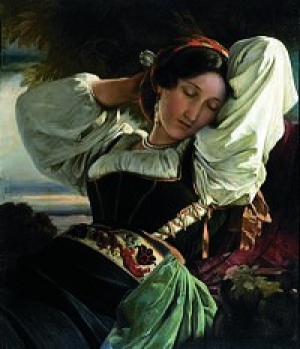 Franz Xaver Winterhalter (1805-1873)
Franz Xaver Winterhalter (1805-1873)
- U.S. Court of Appeals upholds Judge Lisi's decision in Winterhalter case.
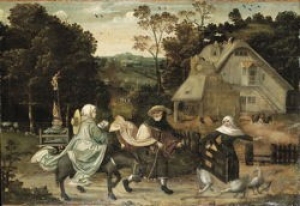 Circle of Jan Wellens de Cock (c. 1480-1527)
Circle of Jan Wellens de Cock (c. 1480-1527)
- "Flight into Egypt" by Jan Wellens de Cock (c1480 - 1527) returned in Berlin with the assistance of Christie's.
2009
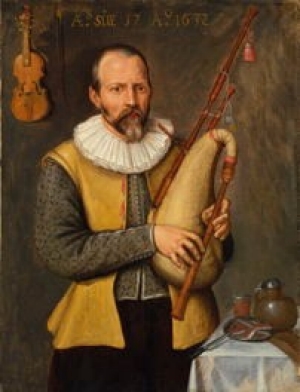 Northern Netherlandish 6 School (17th century)
Northern Netherlandish 6 School (17th century)
- Owing to the Court of Appeals decision, "Portrait of a Musician Holding Bagpipes" c.1632 by Netherlands School returned in New York with the assistance of US Department of Justice and Homeland Security.
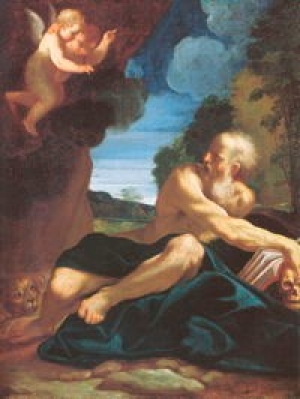 Lodovico Carracci (1555-1619)
Lodovico Carracci (1555-1619)
- "St. Jerome" by Ludovico Carracci (1555-1619) returned in New York with the assistance of US Department of Justice and Homeland Security.
- Lempertz auction house reluctantly withdraws from sale painting by Alexander Adriaennsen. Despite requests for its restitution by the Stern Estate, Lempertz returns work to the consignor.
- More than 200 Stern works, including those forcibly auctioned at Lempertz in 1937, are registered by Interpol as stolen.
2010
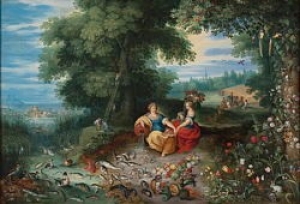 Jan Brueghel the Younger (Brueghel II) (1601-1678)
Jan Brueghel the Younger (Brueghel II) (1601-1678)
- The Stern Estate and Wiesbaden Museum work together to resolve the provenance of paintings. As a result of these efforts the Museum returns Pieter de Grebber painting to the heirs of Jakob and Rosa Oppenheimer. The Stern Estate waived its right to the claim once it was established that the Oppenheimers had been the first Jewish owners to lose possession of it during the Nazi period.
- Upon recommendation of their Restitutions Committee, the government of the Netherlands returns the painting, "Allegory of Earth and Water" by Jan Brueghel the Younger.
2011
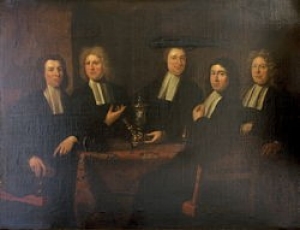 Juriaen Pool II (1665-1745)
Juriaen Pool II (1665-1745)
- After further research into the provenance of Jan Steen's Brawl at a Tavern, the Max Stern Estate determines that this painting owned by Dr. Stern in 1935 was not sold as the result of Nazi persecution.
- German casino restitutes "The Master's of the Goldsmith Guild in Amsterdam in 1701" by Juriaen Pool II to the Estate. Ceremony takes place at Amsterdam Museum.
2013
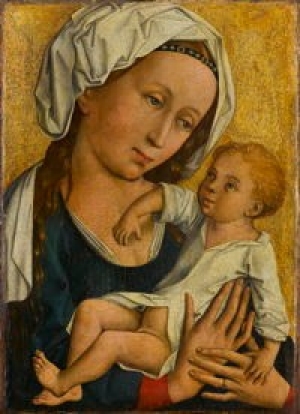 Master of Flémalle (1375-1444)
Master of Flémalle (1375-1444)
- The State of Baden-Wurttemberg requests that the Staatsgalerie Stuttgart return to the Estate, “Virgin and Child” said to be by fifteenth-century Renaissance painter, the Master of Flémalle. Ceremony takes place at the Canadian Embassy in Berlin, as part of the official handover of the chair from Belgium to Canada of the International Holocaust Remembrance Alliance.
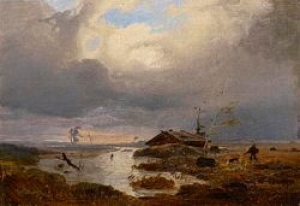 Andreas Achenbach (1815-1910)
Andreas Achenbach (1815-1910)
- Following repeated attempts with members of the German art trade over more than a decade, Van Ham Fine Art Auctions facilitates the return of a painting by Andreas Achenbach. Ceremony takes place at the Canadian Embassy in Berlin.
2014
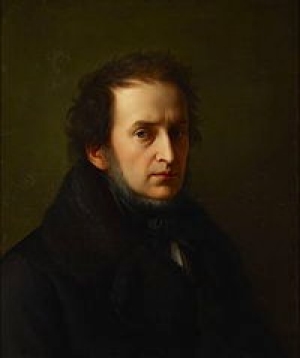 Wilhelm Schadow (1788-1862)
Wilhelm Schadow (1788-1862)
- Regional Capital Düsseldorf returns Self-Portrait of Wilhelm Schadow. Painting is placed on loan to the Stadtmuseum - Landeshauptstadt Düsseldorf.
- Stadtmuseum - Landeshauptstadt Düsseldorf announces platform for international scholarly collaboration leading to an exhibition on Galerie Stern slated for 2018.
- The Masters of the Goldsmith Guild in Amsterdam in 1701 by Juriaen Pool II (1665-1745) is acquired by the Taxation & Customs Museum in Rotterdam and placed on permanent display.
2016
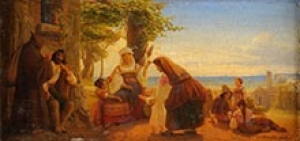 Wilhelm von Krafft ( 1815-1910)
Wilhelm von Krafft ( 1815-1910)
- Following an anonymous tip of the painting’s slated sale, the German Lost Art Foundation – a government supported agency in Magdeburg – alerts representatives of the Stern Foundation who in turn contact the Düsseldorfer Auktionshaus.
- The company promptly returns the work. Ceremony takes place at the Stadtmuseum - Landeshauptstadt Düsseldorf
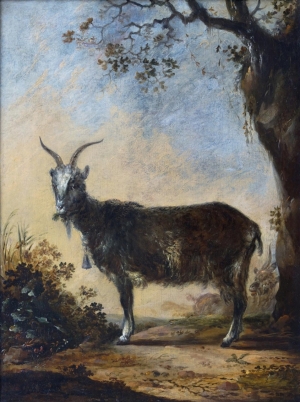 Willem Buytewech the Younger (1625-1670)
Willem Buytewech the Younger (1625-1670)
- Stahl Auktionhaus in Hamburg facilitates return of “Landscape with Goats” by Willem Buytewech.
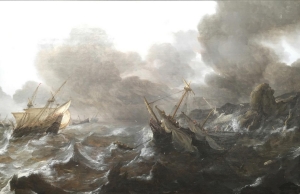 Jan Porcellis (1584-1632)
Jan Porcellis (1584-1632)
- Metz Auktionhaus in Heidelberg facilitates return of marine painting by Jan Porcelis.
- Both the Porcellis and Buytewech works are unveiled at a return ceremony at the Canadian Embassy in Berlin.
- The German Friends of Hebrew University Jerusalem announce that all future works restituted from German collections will qualify for tax certificates.
2017
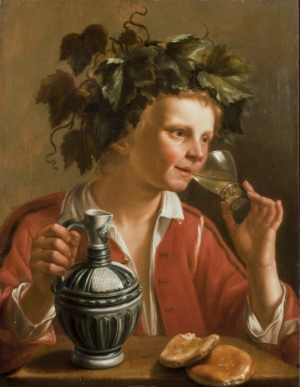 Jan Franse Verzjil (1599-1647)
Jan Franse Verzjil (1599-1647)
- FBI seizes work at 2015 Spring Masters Art Fair in NYC
- Return Ceremony at the Jewish Museum of Heritage, NYC
2018
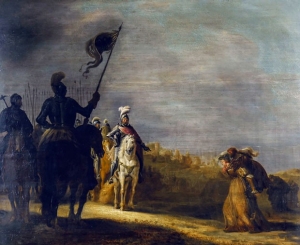 Gerrit Claesz Bleker
(Dutch, 1592-1656)
Gerrit Claesz Bleker
(Dutch, 1592-1656)
- In the presence of officials from the World Jewish Congress, Uwe Grobshäuser, deputy mayor of the City of Weinsberg, returned the Dutch Golden Age painting “Women of Weinsberg” by Gerrit Claesz Bleker.
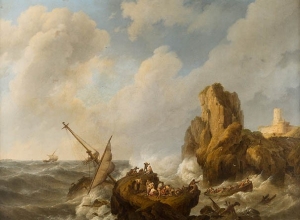 Johannes Hermanus Koekkoek
(1778-Amsterdam 1851)
Johannes Hermanus Koekkoek
(1778-Amsterdam 1851)
- Funded by the German government, The Stern Cooperation Project is launched at the Zentralinstitut fur Kunstgeschichte, Munich.
- Dusseldorf’s Hargesheimer Auction House returns Dutch marine painting by J.H. Koekkoek.
2019
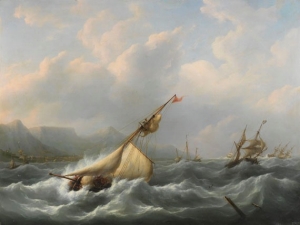 Martinus Schouman
(Dutch, 1770-1838)
Martinus Schouman
(Dutch, 1770-1838)
- Stormy Sea by Martinus Schouman (1770-1838) was in the Galerie Stern inventory in 1935. The painting last appeared on the market in 2014 at Ketterer Kunst in Hamburg. The buyer of the work, a collector from southern Germany, preferred to retain the painting and the Stern heirs were fully compensated.
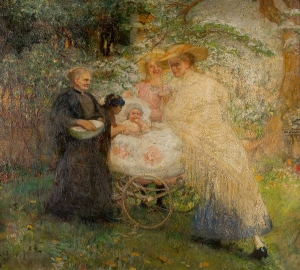 Otto Heichert
(German, 1868-1946)
Otto Heichert
(German, 1868-1946)
- Happy Family in Garden by Otto Heichert (1868-1946) was in the 1937 forced sale of Galerie Stern inventory at Lempertz auctioneers. The painting re-surfaced in 2018 at Hargesheimer Kunstauktionen. Following exchanges with the Düsseldorf auction house, a settlement offer was made, allowing the purchaser to keep the painting and full compensation made through the German Friends of Hebrew University tax certificate program.
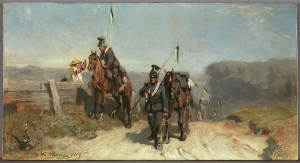 Hans von Marées
(German, 1837-1887)
Hans von Marées
(German, 1837-1887)
- The German Advisory Commission on the Return of Cultural Property Seized as a Result of Nazi Persecution, Especially Jewish Property (formerly known as the Limbach Commission) determines that Uhlans on the March by Hans von Marées (1837-1887) held by Munich’s Neue Pinakothek be returned to the Stern Foundation. The commission’s report duly recognizes Stern as a Jewish businessman that was a victim of Nazi policies as far back as 1933. The formal acknowledgement of an earlier persecution narrative compels the Stern Project to substantially supplement its current list of claimable works.
2020
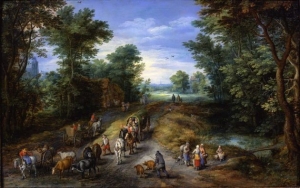 Jan Brueghel the Elder
(Flemish, 1568-1625)
Jan Brueghel the Elder
(Flemish, 1568-1625)
- Swiss art dealer, David Koetser, and the Stern Foundation reach a settlement on Jan Brueghel the Elder’s most important woodland scene. The National Gallery of Art in Washington then acquires the painting from the dealer with support from the Virginia-based Lee and Juliet Folger Fund.
2021
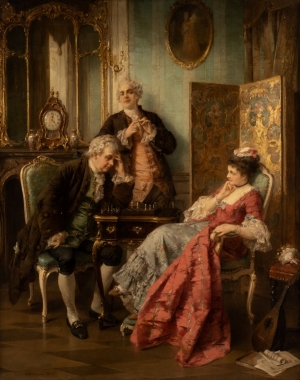 Otto Erdmann (German, 1834-1905)
Otto Erdmann (German, 1834-1905)
- Dusseldorf’s Hargesheimer Auction House facilitates the return of “A Difficult Move” by Rococo Revival painter, Otto Erdmann (1834-1905).
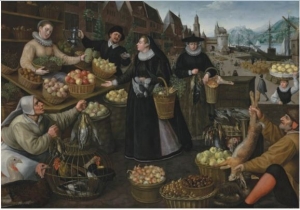 Lucas van Valckenborch (German, 1566-1638)
Lucas van Valckenborch (German, 1566-1638)
- Brokered by Christies, the restitution of this large-format market scene by a member of one of the most prominent Flemish families of artists, was pursuant to an agreement between the current owner and the Stern Foundation.
2023
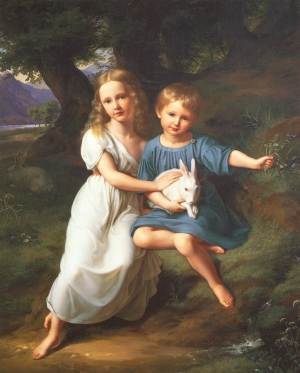 Wilhelm von Schadow (German, 1788-1862)
Wilhelm von Schadow (German, 1788-1862)
- After more than ten years of settlement attempts and politically-driven delays, a master work by the nineteenth-century head of the Düsseldorf School, Wilhelm von Schadow, is returned by the City of Düsseldorf. The Stern Foundation agrees to sell the painting to the City where it will remain on public view at the Kunstpalast.
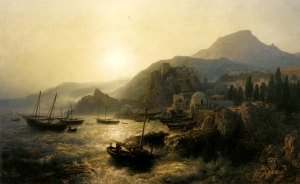 Andreas Achenbach (German, 1815-1910)
Andreas Achenbach (German, 1815-1910)
- "Calabrian Coast" by Andreas Achenbach was pulled from a 2017 exhibition at the Museum Kunstpalast Düsseldorf after the painting was verified to have been listed on the German government-funded, Lost Art Database. The lender of the work, Wolfgang Peiffer, subsequently filed suit against the Stern Foundation in the German courts demanding that the work be de-listed from the database - claiming that it impairs his ownership rights. After two consecutive losses in the regional court and in the higher regional court, the Federal Court of Justice rejects his appeal in July 2023. An unprecedented victory in the German legal system for all victims of Nazi looted-art-loss seeking just and fair solutions.
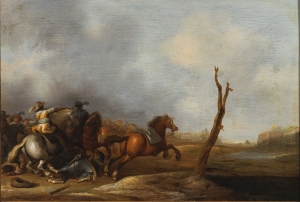 Jan Jacobsz van der Stoffe (Dutch, 1611-1682)
Jan Jacobsz van der Stoffe (Dutch, 1611-1682)
- The Dorotheum auction house in Vienna facilitates the return of "Rider in a Battle in front of a Fortified City" by Dutch Old Master battle-scene painter, Jan Jacobsz van der Stoffe.
- In partnership with the Stadtmuseum Düsseldorf, the Stern Foundation launches a research project titled, "Galerie Stern, Düsseldorf: Transaction with Jewish Customers 1933-1935". The project is in cooperation with the Landesverband der Jüdischen Gemeinden von Nordrhein K.d.o.R (State Association of Jewish Communities of the North Rhine) and funded by the Deutsches Zentrum für Kulturgutverluste (German Centre for the Loss of Cultural Property).
Max Stern lifetime chronology
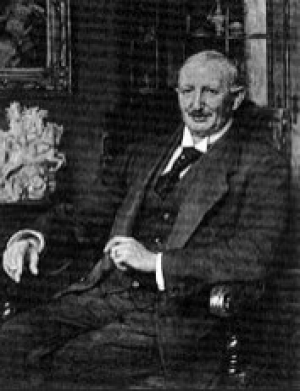 Portrait of Julius Stern by Eduard von Gebhardt (1838–1925). About 1915, Stern is portrayed in his apartment over the gallery in Düsseldorf.
Portrait of Julius Stern by Eduard von Gebhardt (1838–1925). About 1915, Stern is portrayed in his apartment over the gallery in Düsseldorf.
National Gallery of Canada, Library and Archives, Fonds Max Stern
1904
April 18, Max Stern, the youngest child of Julius Stern and Selma Heilbron, is born in München-Gladbach (today Mönchengladbach), Germany. Julius is a prosperous clothing manufacturer in a city centred around the textile industry. Max has two sisters, Hedi and Gerda.
1913-1916
Julius Stern, an art collector since the late 19th century, has contacts and friends in academic and museum circles. He becomes an art dealer, opening the Galerie Julius Stern at 48 Charlottenstrasse, and then at 23 Koenigsallee, Düsseldorf.
1923-1928
In this favourable environment, Max Stern studies art history at the universities in Berlin, Cologne, Bonn and Vienna. In 1928, he obtains a Ph.D. in art history from Bonn University, where he defends his dissertation on the academic German painter Johann Peter von Langer (1756-1824). The majority of his teachers in Bonn are friends and contacts of his father's, including the art historian Karl Koetschau, the mentor who suggested the subject of the young Stern's thesis. His studies complete, Stern works alongside his father at the family gallery in Düsseldorf, which deals mainly in academic painters and Old Masters.
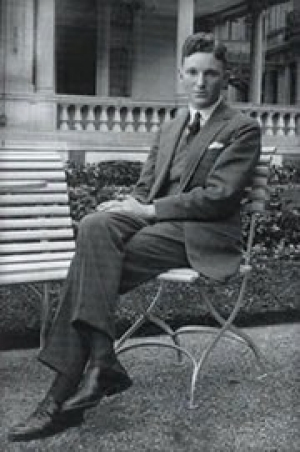 Max Stern. About 1920 National Gallery of Canada.
Max Stern. About 1920 National Gallery of Canada.
Library and Archives, Fonds Max Stern
1930
A version of his dissertation, Johann Peter Langer, sein Leben und sein Werk, is published by Kurt Schroeder of Bonn.
1934-1938
At the death of his father in 1934, Max becomes sole proprietor of the gallery and contemplates opening other galleries outside Germany, in particular in London and New York. Max's sister Hedi Stern Selbiger and Dutch art historian Cornelis van de Wetering, a former assistant to Karl Koetschau in Berlin, found West's Galleries at 43 Duke Street, London, which opens in May 1937.
The meteoric rise of Nazism and anti-Semitism in Germany prevents Stern from working as an art dealer. Stern closes the Düsseldorf gallery in 1937 and sells 228 of the gallery's paintings at Mathias Lempertz, in Cologne. His own and his mother's personal collections are left on consignment with Josef Roggendorf, also in Cologne, who is prohibited from taking them outside Germany. Two agencies, including the Gestapo, confiscate most of these works in 1939 and 1941.
Stern leaves Germany on December 23, 1937, visiting Gerda and her family in Paris, then arriving in London on January 25, 1938, where he joins his sister Hedi at West's Galleries.
1939
In January 1939, with war threatening, Max has the large family art library shipped to London. It includes the Koetschau collection among others. Stern visits various American cities including New York and Los Angeles. Halifax, his only stop in Canada is a stop-over on his trip from London to New York. Following the invasion of Poland in September 1939, Great Britain declares war on Germany. Stern, considered a civilian alien, is detained in an internment camp on the Isle of Man.
1940
The London gallery closes. Stern is interned in Canada in July 1940, first near Fredericton, New Brunswick, then in Farnham, Quebec.
1941
After an internment of nearly two years, Stern decides to settle in Montreal. The art market there is dominated by a few conservative commercial galleries specializing mainly in picturesque landscapes.
In December, Rose Millman founds the Dominion Gallery of Fine Art in the Keefer Building, 1448 Sainte-Catherine Street West.
1942
Stern's expertise impresses Rose Millman, who appoints him director of the Dominion Gallery of Fine Art in October. She introduces Stern to Maurice Gagnon, an art historian, critic and teacher at the École du Meuble, who urges him to make the Dominion Gallery the main commercial distribution point for "living art."
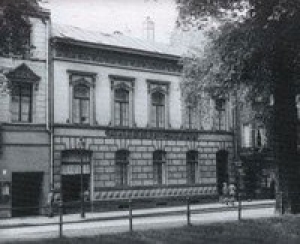 Exterior of the Galerie Stern, 23 Koenigsallee, Düsseldorf, undated (before 1937).
Exterior of the Galerie Stern, 23 Koenigsallee, Düsseldorf, undated (before 1937). National Gallery of Canada, Library and Archives, Fonds Max Stern
1943
In March, Stern organizes his first event, a Goodridge Roberts exhibition presented by Gagnon. Roberts signs an exclusive contract, a new arrangement that becomes a major asset for the gallery while providing a financial base to a number of artists.
Among the other Canadian artists and groups presented are Borduas--the painter's first exhibition in a commercial gallery; the Sagittaires, made up largely of young students of Borduas, organized by Gagnon; the first of several exhibitions of the Contem-porary Arts Society; and four members of the Group of Seven.
Stern's interest in modern French painting takes the form of an exhibition of works by Fernand Léger.
1944
John Lyman, who plays an important role as a critic in the Montreal art community, has his first solo show at the gallery. He is among the artists who sign exclusive contracts with the dealer.
Exhibition of Modern French and Other Important European Artists again attests to Stern's affinity for modern French painting.
During a trip to the Canadian West, Stern meets Emily Carr in Victoria and convinces her to exhibit. This would be the artist's only commercial success during her lifetime. Siegfried Thalheimer, the husband of Max's sister Gerda, founds Fine Art Associates in New York, in partnership with Otto Gerson. October 10, Stern becomes Rose Millman's business partner.
1945
Following the death of Emily Carr, Stern organizes a commemorative exhibition of her works. He would remain her main dealer. Stanley Cosgrove, with whom Stern would sign an exclusive contract that lasted until 1964, presents his first solo exhibition at the gallery.
1946
January 15, Stern marries Iris Ester Westerberg in New York. He goes to London to recover many of his paintings and his large library.
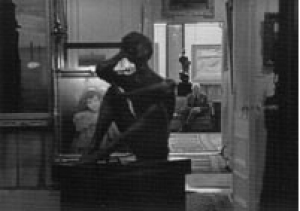 Max Stern at the Dominion Gallery, 1438 Sherbrooke Street West, Montreal, undated.
Max Stern at the Dominion Gallery, 1438 Sherbrooke Street West, Montreal, undated.Photo: Jacques Dufresne, National Gallery of Canada, Library and Archives, Fonds Max Stern
1947
In January, Max and Iris Stern take over ownership of the Dominion Gallery. The exhibition Old Masters, 16th, 17th, and 18th Century comprises 22 works by Old Masters, certain from the former Julius Stern collection. Stern deals similarly with other works from the collection, which he gradually recovers; two works are found with the support of the Canadian government.
1950
The Dominion Gallery moves to 1438 Sherbrooke Street West. The new premises include 14 showrooms on three levels; the Sterns live on the floor above. Temporary exhibitions are held in the basement, Canadian and international modern art is exhibited on the ground floor, and Old Masters and the library are on the second floor, a general arrangement that was not to change greatly. The inaugural event is a Goodridge Roberts exhibition.
1951
Stern meets Edward J. Hughes during a trip to the Canadian West. In 1953, the gallery holds its first exhibition of this artist and would remain his sole agent until closing.
1954
A solo exhibition of Jean Dallaire confirms Stern's interest in the artist, with whom the dealer would sign an exclusive contract in 1963. A first solo exhibition of Marian Scott would also lead to a contract.
1956
Stern visits Henry Moore in Much Hadham, England. Moore puts him in touch with other English, French and Italian sculptors. In the coming years, the gallery was to concentrate on modern sculpture. Max and Iris visit the studio of Kees Van Dongen, a French artist well represented in their collection.
1959
A modern extension to the back of the building doubles the Dominion Gallery's exhibition space. Max and Iris Stern make their first donation to a Montreal public collection: the Montreal Museum of Fine Arts receives View from My Studio (about 1921-1925), an oil painting by Mabel May.
1963
Stern makes a first gift to Sir George Williams University (now Concordia University), Blue Drawing as Sculpture (1956), a tempera on paper by Peter Winchell Sager.
1964
Stern organizes a substantial exhibition of 20th century European sculpture at the gallery. He makes a first gift to the Musée d'art contemporain de Montréal: Oriental Pattern (1963), an ink drawing on paper by Georges Mathieu, whom the gallery had given a solo exhibition in 1963.
1967
An exhibition in honour of the 50th anniversary of Rodin's death takes place at the gallery in cooperation with the Musée Rodin, Paris. From the late 1950's, the Paris museum granted Stern exclusive rights to sell the artist's sculpture in Canada. He purchases the statue of Jean d'Aire, from the group The Burghers of Calais, and installs it in front of the gallery.
1968
Michel Moreault becomes the gallery's assistant director.
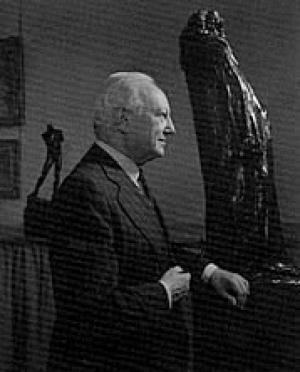 Stern at the Dominion Gallery.
Stern at the Dominion Gallery. 1985 Yousef Karsh (1908 – 2002)
National Gallery of Canada, Library and Archives, Fonds Max Stern Cat. 21
1978
Iris Stern dies in Palm Beach, Florida.
1983
Hedi Stern Selbiger dies in England.
1984
Stern receives the Order of Canada.
1985
Stern receives an honorary doctorate from Concordia University.
1987
May 30, Max Stern dies of a heart attack on a business trip to Paris. In accordance with his wishes, the gallery remains in operation under Michel Moreault and the supervision of the Max and Iris Stern Foundation. Stern bequeaths his private collection to Canadian museums (notably the Montreal Museum of Fine Arts and the Musée d'art contemporain de Montréal), two museums in the United States and the Israel Museum, Jerusalem.
1994
Gerda Stern Thalheimer dies in New York.
1997
A list of 3,000 books from Stern's library is drawn up before they are ceded jointly to McGill and Concordia Universities, as well as Hebrew University in Jerusalem.
2000
In December, the Dominion Gallery changes hands. The Stern estate gives the archives to the National Gallery of Canada.
Chronology written by Jacques Desrochers, Curator of Canadian Art at The Montreal Museum of Fine Arts for the catalogue "Max Stern Montreal Dealer and Patron", 2004. Co-published by the Leonard & Bina Ellen Gallery, Concordia University and the Montreal Museum of Fine Arts.

